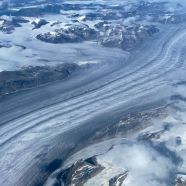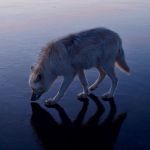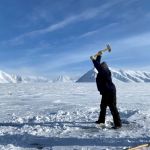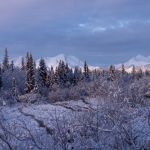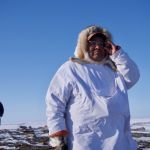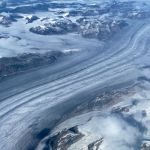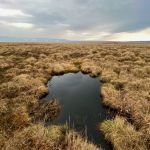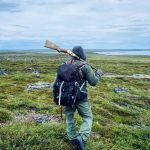Change of State
Early one winter in northwestern Alaska I had occasion to sit around and watch a river freeze. It took a week. When I arrived, shortly before Halloween, rafts of ice were floating west down the river and along either bank tentative platforms of ice were creeping out over the water, like plaque slowly occluding an artery. The channel was still open, though, and the river hadn’t yet lost its autumnal stride: it looked strong, deep, unstoppable. Against the white of the ice the water lay flat and otherworldly black, the color not of engine oil but maybe very old engine oil—something in any case that had been born in high heat, under heavy pressure. The water seemed to swallow light, and later I imagined that it must be the color of the galactic sludge you could find in the belly of a black hole.
I had gone to that part of the Kobuk River to observe migrating caribou, not to watch the river freeze up. For most of the last 10,000 years caribou had been arriving to that spot on the river each autumn and swimming across to their wintering grounds on the other side. But that year they’d arrived late, after the river had begun its annual phase change—its transformation from a liquid state to a solid one. The river had grown too spotty with ice for the animals to swim safely, and so they would have to wait it out. This was excellent, because it meant thousands, perhaps tens of thousands, of caribou were crowding the riverbank and forests around me.
The caribou, of course, were not happy. They’re spooky creatures, hard to approach. They don’t like new stuff. Anything that suggests the nearness of people—a cairn, a fence, a road—can drive them to distraction, even cause them to turn and beat it. An actual human can cause great ripples of stress to run through a herd. But soon the animals on the Kobuk seemed to realize I wasn’t a hunter come to shoot them, and eventually their fear downgraded into mere annoyance. Then they went back to doing the neurotic things caribou do when they’re waiting for something to happen. They paced along the river. They stampeded now and then for no obvious reason and crashed like runaway SUVs through thickets of young willow. They jousted, too, and mounted one another, and occasionally they did something I had never observed in animals before: they spent long mournful periods staring into the dark water, as though they glimpsed something there, or hoped to stop its motion with the weight of their longing alone.
Through all of this the river froze. Little by little, day by day. Evenings brought new frigid lows and with these arrived new forms of ice. Each morning I crawled out of my tent and went down to the river for water, and to see how the freeze was coming along. The early ice rafts grew larger and more numerous, and they were followed by ice in the shape of pancakes, and then pieces that looked like piles of window panes, or jumbled swords, or half-submerged cars. There was such variety, such parade-like fancy, that I began to think of each piece emerging from a workshop far upriver where they were hand-sculpted, no two alike.
And the sounds! I wish I had recorded them for you. Loud ones, like boulders colliding, or soft ones, like the faint tinkle of shattered Christmas ornaments. Sometimes it sounded as though someone was hauling trash bags full of beer bottles downriver, and once or twice I was startled awake in the middle of the night by a strange boom, followed by a crackling, as after a shower of fireworks. It always took a few moments for me to come to my senses and remember that it was just the river, talking to itself, urging itself on through the change. Finally at the end of the week all I could hear was a sandpapery hiss, low and constant, as the water finally vanished beneath a rumpled sheet of ice that was no longer artisanal but instead uniform and corporate-looking—a heavy white belt sliding toward the sea.
Looking back, I realize that I’d never before witnessed a real freeze. For those of us in the northern, and often wealthier, parts of the world, the process of going solid is something of a quiet foregone conclusion. We put trays of water in the freezer and never doubt the outcome. We go to bed on cold winter nights and expect in the morning to find puddles like black mirrors, ponds gray and lidded. While I have worked in many parts of the Arctic I have never attended to the actual formation of ice, though it is everywhere, though it is the very substance that defines the region. I had not considered, for example, how the elemental change from one form into another could so completely block the migration of caribou, and thereby constrict one of the largest and most consequential movements of animals—of blood, heat, and nutrients, of life itself—anywhere on earth.
Perhaps I am thinking of my stay on the Kobuk more lately because my home city of New York is suffering through a prolonged heat wave. Weeks of temperatures in the 90s. At this point even the squirrels have given up and lie draped over branches in the oaks. We can’t really complain, of course. This is a rich city, in a rich country. We have options and responsibilities we routinely choose to ignore. But I’m not remembering the river merely out of nostalgia for a colder time. I realize that the memories carry a powerful kind of regret. Even a creeping sadness. The truth is that almost everywhere there is now less ice. It comes later, as they caribou were learning, and melts faster, as they would probably discover in the spring. These days it seems you can never be sure when, or for how long, you will ever be truly cold again.
On one of my last Kobuk mornings I came out to fetch water and spotted two ravens coming downriver. I don’t mean they were flying. They were riding the ice. Standing together on a huge raft in the middle of the current, letting themselves be carried along. The spectacle filled me with such happiness that I almost dropped my coffee pot into the water. The birds eyed me, then turned back to the view ahead—the vast and almost silent landscape, the snow-covered firs along the banks, white hills rising into white mountains under a sparkling sun, a flawless sky.
Were they friends, mates, sisters? Where were they headed? Whose idea was this? Maybe I should’ve shouted these questions at them—ravens have been known to answer. Whatever the story, they were clearly enjoying themselves. It had the feeling of last hurrah. In a day, or less, such a ride would no longer be possible. For the caribou this meant joy: soon they would be able to walk over the ice. But for the birds—the poor birds!—it would mean going back to business as usual, days spent flapping over a world gone still. I watched the ravens until they disappeared around a bend, until I couldn’t feel my toes anymore for the cold. Then I hobbled back up to camp to build a fire.
- An Arctic wolf noses along a frozen pond on Ellesmere Island, Nunavut, Canada.
- Outside Anaktuvuk Pass, Alaska, a woman chops ice from a frozen lake. She’ll carry it back to town and melt it for drinking water.
- Cody Mantla and John Boline, members of the Tłı̨chǫ First Nation, clean fish at a remote camp on the shore of Contwoyto Lake in the barren lands, Northwest Territories.
- Caribou trails run through brush above the Kobuk River in Western Alaska. In the distance rise the Jade Mountains.
- Paul Ikkualaq (right) and Ikey Nashooraitook scan for caribou on the mainland south of Gjoa Haven in Nunavut, Canada.
- A glacier in southern Greenland.
- Meltwater pools on the tundra in the Utukok hills on Alaska’s North Slope.
- Roy Judas, a member of the Tłı̨chǫ First Nation, follows caribou trails across the barren lands in Nunavut, Canada.
*All photographs taken by the author.


